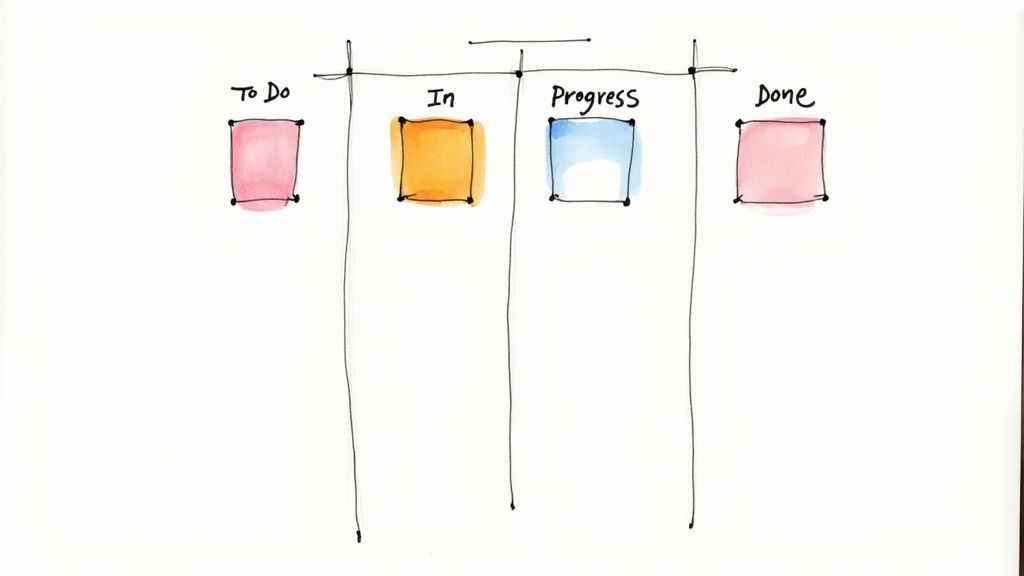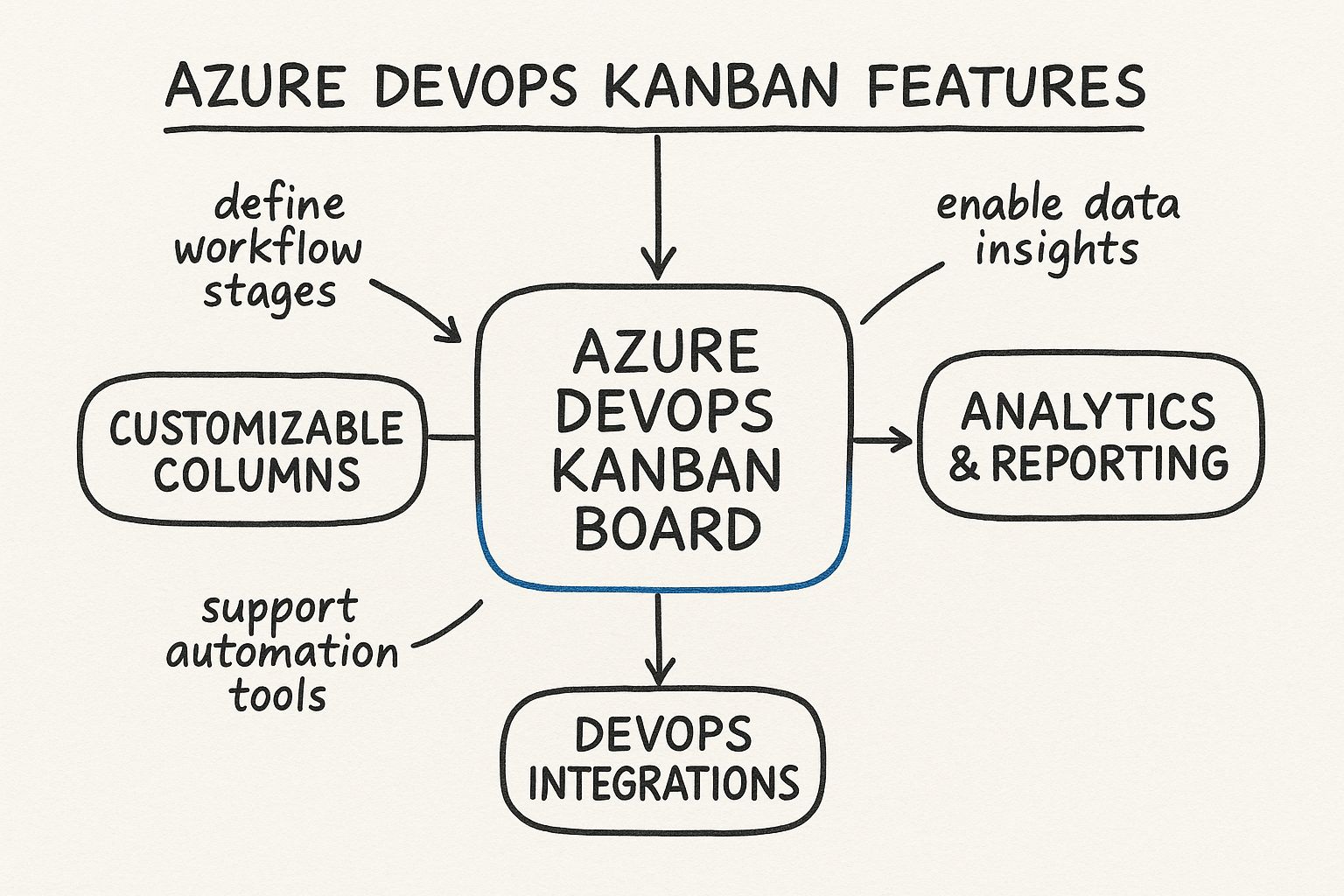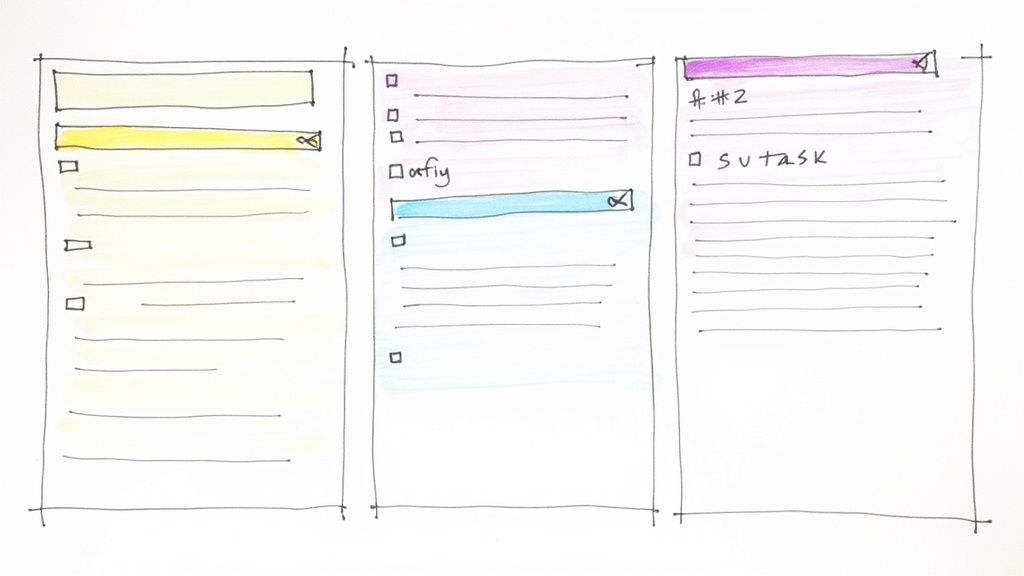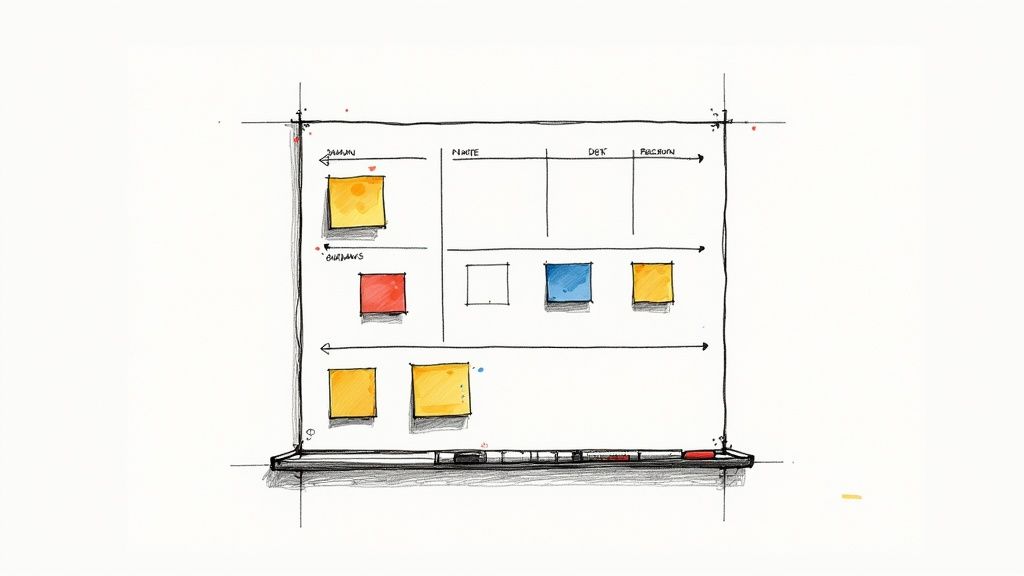
Top 7 Kanban Board Examples to Boost Your Workflow
Discover 7 effective kanban board examples, from digital to physical, to streamline your team’s workflow. Find the perfect kanban board examples today!

Visualize Your Way to Success: Exploring Kanban Board Examples
This listicle provides practical kanban board examples to help your team visualize and streamline workflows. Discover how different platforms, from Trello to physical boards, can be used for efficient project management. Whether you're a project manager, sales representative, or freelancer, finding the right kanban board improves organization and boosts productivity. Explore these diverse kanban board examples, including Trello, Jira, and Asana, to identify the perfect solution for your team. Optimize your workflow and achieve project success with the right kanban solution.
1. Trello Kanban Board
Trello, a highly visual project management tool, stands as a prime example of a kanban board in action. It uses a system of boards, lists, and cards to represent projects, stages, and individual tasks respectively. This structure allows teams to visualize their workflow, track progress, and manage tasks collaboratively. Trello's drag-and-drop interface makes it incredibly easy to move tasks between stages, reflecting their real-time status. This makes it a popular choice for teams seeking an intuitive and flexible kanban board example.

Trello's strength lies in its simplicity and versatility. Teams can customize their boards with labels, due dates, checklists, attachments, and comments, fostering detailed task management and clear communication. Power-Ups, which are integrations and add-ons, extend Trello’s functionality further, connecting it with other tools and services. This flexibility makes it suitable for diverse project types and industries, from software development and marketing to product management and even personal task organization.
Features:
- Drag-and-drop interface
- Power-Ups (integrations and add-ons)
- Card labels, checklists, due dates, and attachments
- Commenting and @mentions
- Activity log and notifications
- Mobile apps for iOS and Android
Pros:
- Extremely intuitive and user-friendly
- Free tier is robust enough for small teams
- Highly visual with customizable backgrounds
- Extensive third-party integrations
- Flexible for various project types and industries
Cons:
- Limited reporting capabilities in free version
- Can become cluttered with large-scale projects
- Advanced features require a paid subscription
- Not as robust for complex project management needs
Examples of Successful Implementation:
- Software development teams using Trello to track user stories and bugs, facilitating agile development.
- Marketing teams managing content calendars, scheduling posts, and tracking campaign progress.
- Atlassian (Trello's parent company) uses Trello internally for various projects, demonstrating its efficacy.
- Fender guitars utilizes Trello for product roadmap management, visualizing their product development lifecycle.
Tips for Effective Trello Kanban Board Usage:
- Use color-coded labels to categorize tasks visually, enhancing organization and clarity.
- Set up automation rules (using Butler or other Power-Ups) to move cards between lists based on triggers, streamlining workflow.
- Implement WIP (Work In Progress) limits to prevent bottlenecks and focus on completing tasks efficiently.
- Utilize the Calendar Power-Up for timeline visualization, gaining a broader perspective on project timelines.
- Archive completed cards regularly to keep boards clean and maintain focus on active tasks.
When and Why to Use Trello:
Trello is an excellent choice for teams and individuals who need a simple, visual, and flexible kanban board solution. Its user-friendly interface makes it easy to get started, while the free tier offers sufficient functionality for many small teams. Trello’s adaptability makes it ideal for various project types, from simple task management to more collaborative project workflows. However, for complex projects requiring advanced reporting or resource management, more robust project management tools might be necessary.
Trello’s widespread popularity, fueled by Atlassian's acquisition and the vision of its co-founders Joel Spolsky and Michael Pryor, has solidified its place as a leading kanban board example. Its ease of use, visual appeal, and extensive integrations make it a valuable tool for teams seeking to improve their workflow and embrace the benefits of kanban. Visit Trello
This kanban board example deserves its place in the list due to its widespread adoption, ease of use, and the power it provides teams to visualize and manage their work effectively. It's a compelling starting point for anyone exploring the world of kanban.
2. Jira Software Kanban Board
Jira Software Kanban boards are a powerful way for software development teams to visualize and manage their work, earning their place on this list of kanban board examples due to their robust features and widespread adoption. Combining the principles of kanban methodology with agile project management, Jira provides a platform to track issues, bugs, and user stories throughout their entire lifecycle. This makes it an ideal solution for teams looking for a comprehensive project tracking tool within a kanban framework.
How it Works:
Jira's Kanban boards represent your workflow visually, with columns representing different stages of development (e.g., To Do, In Progress, Code Review, Testing, Done). Issues, represented as cards, move across these columns as work progresses. Jira’s strength lies in its customization. You can tailor workflows, board configurations, and even issue types to perfectly match your team's specific process. Features like swimlanes allow for further organization, grouping issues by project, team, or other relevant criteria.
Key Features and Benefits:
- Customizable Workflows: Design your workflow stages to mirror your development process.
- Advanced Filtering and Search: Powerful JQL (Jira Query Language) lets you find exactly what you need, quickly.
- Swimlanes: Organize related issues for better clarity and focus.
- Integrations: Connect with development tools like GitHub and Bitbucket for a seamless workflow.
- Detailed Reporting: Track key metrics like lead time, cycle time, and cumulative flow diagrams (CFD) to identify bottlenecks and optimize performance.
- Automation: Automate repetitive tasks, such as status updates and assignments, freeing up your team to focus on development.
Pros:
- Comprehensive project tracking tailored for software teams.
- Granular permission controls and user roles for enhanced security.
- Rich reporting capabilities provide valuable insights into project progress and team performance.
- Enterprise-grade security and compliance features for peace of mind.
Cons:
- Steep learning curve for new users.
- Can be complex to set up and maintain, potentially requiring dedicated administrators.
- Higher cost compared to simpler kanban tools.
- Configuration changes might require admin privileges.
- Performance can slow down with large datasets.
Examples of Successful Implementation:
Jira is used by some of the biggest names in tech, demonstrating its effectiveness for managing complex software projects. Companies like Spotify, eBay, Twitter, and even NASA’s Jet Propulsion Laboratory leverage Jira for their mission-critical projects.
Tips for Effective Use:
- Plan Your Workflow: Carefully design your workflow states before implementation to ensure it accurately reflects your process.
- Limit Work in Progress (WIP): Use WIP limits to prevent bottlenecks and ensure a steady flow of work.
- Automate: Set up automation rules to reduce manual status updates and other repetitive tasks.
- Visualize Performance: Leverage dashboards to gain visibility into team performance and identify areas for improvement.
- Iterate and Improve: Regularly review and refine your board configuration based on team feedback.
When and Why to Use Jira Software Kanban Boards:
Jira's Kanban boards are particularly well-suited for software development teams who need a powerful tool to manage complex projects, track bugs, and integrate with their existing development workflows. While powerful, its complexity might make it less suitable for smaller teams or those seeking a simpler kanban solution. If you’re looking for a different approach within the Google Workspace ecosystem, you might want to learn more about Jira Software Kanban Board and explore alternative options. Ultimately, the best kanban board solution will depend on your specific needs and context.
3. Microsoft Azure DevOps Kanban Board
The Microsoft Azure DevOps Kanban Board provides a robust visual platform for managing work items throughout the software development lifecycle. Tightly integrated within the larger Azure DevOps ecosystem, it allows teams to visualize their workflow, track progress, and collaborate effectively. This kanban board example shines when used within the Microsoft ecosystem, offering powerful features for agile project management. It goes beyond simple task management by linking work items, mapping dependencies, and offering rich analytics to optimize your development process.

The infographic visualizes the core components of Azure DevOps and how they relate to the Kanban board. The central concept is the "Kanban Board" itself. Branching out from it are key features like "Work Items," representing individual tasks or user stories. "Workflow Stages" (e.g., To Do, In Progress, Done) dictate the flow of work. "Customization" options allow tailoring the board to specific project needs. "Analytics & Reporting" provides insights into team performance. "Integration" highlights connections with other Azure DevOps services like repos and CI/CD pipelines. The strongest relationship depicted is between the Kanban Board and Work Items, demonstrating how the board visually represents the flow of these items. The infographic also emphasizes the connection between the board and Analytics, illustrating the platform's ability to derive actionable insights from the visualized workflow.
As illustrated, the power of the Azure DevOps Kanban Board lies in its comprehensive integration with the broader Azure ecosystem. This makes it particularly valuable for software development teams already invested in Microsoft tools. Features like customizable columns, swimlanes, card fields, and work item linking allow for flexible and detailed workflow management. Built-in analytics and reporting provide valuable insights into team performance and bottlenecks. Teams can set WIP limits, utilize tagging and categorization, and leverage powerful query and filtering options for streamlined workflow management.
Examples of Successful Implementation:
- Microsoft: Microsoft's own development teams utilize Azure DevOps kanban boards for internal projects, showcasing the platform's effectiveness for large-scale software development.
- Siemens: Siemens leverages Azure DevOps to manage large and complex projects, demonstrating its scalability and suitability for enterprise-level initiatives.
- Accenture: Accenture implements Azure DevOps for client projects, highlighting its versatility and adaptability to diverse project requirements.
- Shell: Shell utilizes Azure DevOps as part of its digital transformation initiatives, demonstrating its applicability beyond traditional software development scenarios.
Pros:
- Deep integration with Microsoft development tools and Azure cloud services.
- Enterprise-grade security and compliance features.
- Scalability for large organizations and complex projects.
- Advanced customization options for tailoring workflows.
- Powerful code repository integration and version control.
Cons:
- Can be complex to set up and administer, requiring dedicated resources.
- Primarily designed for software development, limiting its applicability for other project types.
- Requires an Azure DevOps subscription, which can be a cost consideration.
- Less intuitive for non-technical users compared to simpler kanban tools.
- Interface can feel dated compared to some newer alternatives.
Tips for Effective Use:
- Configure card styles to visually highlight important attributes like priority or due date.
- Use parent-child relationships to break down larger work items into smaller, manageable tasks.
- Leverage the analytics service to track key flow metrics like lead time and cycle time.
- Set up dashboards for increased visibility of key performance indicators (KPIs).
- Use the split column feature to track items currently in progress within a specific stage.
When and Why to Use This Approach:
Azure DevOps Kanban Boards are ideal for software development teams already working within the Microsoft ecosystem and seeking a powerful, integrated solution for managing their workflows. If your team needs robust tracking, customization, and deep integration with other development tools, and you are comfortable with a more complex platform, Azure DevOps is a strong contender. However, if you're a smaller team or working outside the Microsoft ecosystem, simpler kanban board examples might be more suitable.
This kanban board example deserves its place in the list due to its comprehensive features and integration within the Microsoft ecosystem. While it may be more complex than some alternatives, its power and scalability make it a valuable tool for large organizations and complex software development projects. Although perhaps not ideal for the target audience of this article (Google Workspace users), its inclusion provides a comprehensive overview of prominent kanban board options available.
4. Asana Kanban Board
Asana's kanban board feature offers a highly visual and flexible way to manage projects and workflows. It works by allowing you to create columns representing different stages of a project (e.g., To Do, In Progress, Review, Done) and then populate those columns with tasks represented as cards. Team members can then drag and drop these cards from one column to the next as work progresses, providing a clear, real-time overview of project status. Asana goes beyond basic kanban functionality by integrating it seamlessly within its broader work management platform, offering features that enhance collaboration and project tracking. This makes it a strong kanban board example for those seeking a robust yet user-friendly solution.

Asana's strength lies in its balance of simplicity and powerful features. Its clean, modern interface is easily adopted by teams of all technical levels, while features like custom fields, subtasks, and dependencies provide the depth needed for complex project management. This adaptability makes it an excellent choice for diverse teams, from software development to marketing and operations. Major organizations like Deloitte, Pinterest, The New York Times, and even Uber utilize Asana's kanban boards, showcasing its effectiveness in managing everything from client projects and marketing campaigns to editorial workflows and operational tasks. This broad adoption speaks volumes about its versatility and suitability as a kanban solution.
Key Features and Benefits:
- Custom Fields: Add details like priority levels, effort estimates, or client names to each task for greater context.
- Multiple Project Views: Switch between Kanban, List, Timeline, Calendar, and Board views to analyze progress from different perspectives.
- Task Dependencies & Relationships: Link tasks together to visualize dependencies and ensure smooth workflows.
- Integrations: Connect with over 100 apps to streamline workflows and centralize information.
- Automation: Automate repetitive tasks, like moving tasks between columns based on status changes, to save time and reduce manual effort.
Pros:
- User-friendly interface suitable for all team members.
- Flexibility to switch between kanban and other project views.
- Robust notification and task assignment features.
- Good balance of simplicity and depth.
- Strong mobile experience for on-the-go project management.
Cons:
- Limited features in the free version (15 users).
- Can be expensive for larger teams.
- Limited customization of card appearance.
- Lacks built-in time tracking.
- Lacks some advanced kanban metrics and analytics.
When and Why to Use Asana Kanban Boards:
Asana is a good fit for teams seeking a visual project management tool that goes beyond basic kanban. If you need a platform that allows you to easily visualize workflow, manage tasks collaboratively, track progress in real-time, and integrate with other tools you already use, Asana is worth considering. It's particularly well-suited for project managers and team leads looking to improve team collaboration and efficiency. Its flexibility also makes it a valuable asset for small and medium-sized businesses and individual professionals managing multiple projects.
Tips for Effective Use:
- Use custom fields to add context and track key information.
- Leverage templates to standardize workflows and save time.
- Set up rules to automate task movement and other actions.
- Use sections within columns to further organize related work items.
- Add start and due dates to visualize timelines and deadlines.
This combination of robust features, ease of use, and wide adoption justifies Asana's place as a leading kanban board example. It provides a powerful yet approachable solution for teams looking to embrace the benefits of visual project management with the added power of a comprehensive work management platform.
5. Monday.com Kanban Board
Monday.com is a popular Work OS platform that offers highly visual and customizable kanban boards as a core feature, making it a strong contender among kanban board examples. This platform excels in providing teams with a flexible and intuitive way to visualize and manage their workflows, from simple task management to complex project coordination. Its strength lies in its adaptability, allowing teams to tailor their boards to specific needs through a wealth of customization options and automations.
How it Works:
Monday.com's kanban boards function by allowing users to create columns representing different stages of a workflow (e.g., To Do, In Progress, Done). Tasks are represented as cards within these columns and can be easily dragged and dropped between them as progress is made. Beyond basic status tracking, Monday.com allows for highly customizable column types, including people, dates, numbers, formulas, and more, offering a comprehensive view of task details. Multiple view options, such as Calendar, Timeline, and Gantt chart, complement the Kanban view, providing further flexibility for project planning and tracking.
Features and Benefits:
- Highly Customizable Columns: Choose from over 30 column types to tailor your board to your specific workflow needs, tracking everything from assignees and deadlines to progress percentages and calculated metrics. This makes it a highly effective kanban board example for various use cases.
- Multiple View Options: Switch between Kanban, Calendar, Timeline, and other views to visualize your data in the most effective way for your current task.
- Automations: Automate repetitive tasks, such as moving items between columns based on status changes, sending notifications, and updating other related items. This significantly reduces manual effort and streamlines workflows.
- Integrations: Connect Monday.com with other tools your team uses, such as Slack, Google Calendar, and Microsoft Teams, to centralize your workflow.
- Collaboration: Facilitate teamwork with features like @mentions, updates, and file sharing directly within the platform.
- Dashboards and Reporting: Gain valuable insights into team performance with customizable dashboards and reports, visualizing key metrics and progress.
Pros:
- Exceptionally Customizable: The vast array of column types and customization options allows for a truly tailored kanban experience.
- Visually Engaging: The colorful and intuitive interface makes it easy to understand project status at a glance.
- Robust Automations: Save time and reduce errors with powerful automation capabilities.
- Versatile: Suitable for a wide range of team types and industries.
- Strong Visualization of Data: Dashboards provide clear insights into project progress and team performance.
Cons:
- Cost: Can be more expensive than some alternative kanban tools, especially for larger teams.
- Overwhelming Options: The sheer number of customization options can be overwhelming for new users.
- Limited Kanban Templates: While Monday.com offers many templates, the selection specifically designed for kanban is somewhat limited.
- Learning Curve: Setting up complex boards with advanced features can require a learning curve.
- Limited Free Plan: The free plan is quite restrictive in terms of features and users.
Examples of Successful Implementation:
- Coca-Cola: Uses Monday.com for marketing campaign management.
- Hulu: Manages content production workflows with Monday.com.
- Adobe: Uses Monday.com for cross-department coordination.
- Discovery Channel: Uses Monday.com for production scheduling.
Tips for Using Monday.com Kanban Boards:
- Use status columns with custom labels and colors to visually represent progress.
- Implement automations to move items between groups based on status changes.
- Utilize dashboard widgets to track team performance metrics.
- Create board templates for repeatable processes.
- Use mirrored columns to sync information across multiple boards.
When and Why to Use Monday.com:
Monday.com is a great choice for teams who need a highly customizable and visual kanban solution within a broader Work OS. Its robust features, automations, and integrations make it ideal for managing complex projects and workflows. If your team values visual project management, needs a platform that can scale with your needs, and is willing to invest in a more comprehensive solution, then Monday.com is a strong option.
Popularized By: Roy Mann (CEO and co-founder), Eran Zinman (CTO and co-founder)
6. Physical Kanban Board
The physical kanban board stands as the original and arguably most tactile implementation of the kanban methodology. This approach uses tangible cards, often sticky notes, moved across a whiteboard or wall to visually represent work items as they progress through various stages. Despite the rise of sophisticated digital tools, physical kanban boards remain a popular choice for their inherent simplicity, immediate visibility, and the strong sense of team engagement they foster. This makes them an excellent kanban board example for teams looking for a straightforward and collaborative approach.

A typical physical board consists of columns drawn on a whiteboard or wall, representing different stages of the workflow (e.g., To Do, In Progress, Done). Each task is written on a card and placed in the appropriate column. As work progresses, team members physically move the cards across the board, providing a clear, real-time visualization of the workflow. Visual indicators such as colored cards, stickers, or magnets can further categorize tasks or highlight priorities. Swimlanes can be added to categorize different work types or projects, while physical tokens or markers help enforce Work-in-Progress (WIP) limits, preventing bottlenecks and encouraging a more focused approach. The physical board also serves as a natural focal point for daily stand-up meetings, facilitating discussion and collaboration.
Companies like Toyota, where kanban originated in its manufacturing facilities, still utilize physical boards. Surprisingly, even tech-forward companies like Spotify’s Swedish offices use physical boards alongside their digital tools, demonstrating the enduring value of this method. Other notable examples include Pixar, which uses physical boards for some animation project tracking, and Boeing, where large physical kanban boards are used for complex aircraft component tracking. These examples highlight the versatility of physical kanban boards across various industries and project scales.
Pros:
- Highly Visible: The entire team can see the project status at a glance.
- Collaborative: Promotes team communication and shared understanding.
- Easy to Use: No technical expertise or software training is needed.
- Engaging: The tactile interaction of moving cards fosters a stronger sense of ownership and engagement.
- Cost-Effective: No subscription fees or software licensing costs.
- Flexible: Easy to adapt and modify as project needs change.
Cons:
- Limited to Co-located Teams: Not ideal for remote or distributed teams.
- Physical Limitations: Cards can get lost or damaged, and board space can be limited.
- No Automatic Data Capture: Manual tracking and reporting of metrics are required.
- Difficult to Share: Hard to share progress with remote stakeholders.
- Maintenance: Requires physical space and upkeep.
- Limited History: Storing historical data can be challenging.
Tips for Effective Use:
- Color-Coding: Use different colored sticky notes for different task types or priorities.
- Document Progress: Regularly take photos of the board to maintain a visual history.
- Strategic Placement: Position the board in a high-traffic area for maximum visibility.
- Secure Attachments: Use magnets or card holders for frequently moved items.
- Assign Ownership: Add avatars or photos to cards to clearly indicate ownership.
- Metrics Tracking: Combine with a simple spreadsheet to track key metrics and generate reports.
When considering your workspace setup and how to minimize distractions, a physical kanban board can be a great asset for co-located teams. Learn more about Physical Kanban Board. This method is particularly beneficial for teams who value face-to-face communication and appreciate the tactile nature of moving cards to track progress. While digital alternatives offer powerful features, the simplicity and tangible nature of the physical kanban board remain compelling reasons for its continued use in various settings. This approach is especially useful for small to medium-sized businesses, project managers, and even individuals who appreciate a visual and hands-on approach to managing their work. It provides a powerful visual representation of workflow, encourages collaboration, and promotes a shared understanding of project status, making it a valuable kanban board example for a wide range of teams and individuals.
7. Kanbanize Digital Kanban Board
Kanbanize is a powerful digital kanban board example, specifically designed for scaling the Kanban method across entire organizations. Unlike generic project management tools that offer kanban boards as a feature, Kanbanize builds its entire platform around the principles of Lean and Kanban, making it a compelling choice for teams serious about optimizing workflow and achieving peak efficiency. This approach makes it deserving of a place on this list, offering a focused and dedicated solution for Kanban implementation.
Kanbanize operates on the core concept of visualizing work items as cards moving across a board through various stages of a workflow. It leverages a hierarchical structure, enabling portfolio-level oversight, team-specific boards, and even personal kanban boards for individual task management. This connectedness allows for seamless work breakdown and progress tracking across all levels of the organization.
How it works: Teams create boards representing their workflows, define stages (columns) that reflect the steps in their process, and populate the board with cards representing tasks or projects. Advanced WIP (Work In Progress) limits help control the flow of work, preventing bottlenecks and ensuring teams focus on completing tasks before starting new ones. Real-time analytics provide valuable insights into cycle time, throughput, and other key metrics, allowing for data-driven improvements.
Features and Benefits:
- Multi-level hierarchical boards: Connect strategic initiatives to team execution and individual tasks.
- Advanced WIP limits and flow control: Optimize workflow and minimize bottlenecks.
- Custom fields and card templates: Tailor Kanbanize to specific project requirements.
- Comprehensive analytics dashboard: Monitor key metrics and identify areas for improvement.
- Automated policies and business rules: Streamline repetitive tasks and enforce process consistency.
- Timeline and workload views: Visualize project schedules and resource allocation.
- Monte Carlo simulations: Forecast project completion dates and potential risks.
Pros:
- Built specifically for kanban methodology implementation: Ensures alignment with core Kanban principles.
- Robust analytics for flow efficiency and bottleneck identification: Data-driven insights for continuous improvement.
- Supports scaled kanban across multiple teams and departments: Facilitates enterprise-wide Kanban adoption.
- Advanced workflow automation capabilities: Saves time and reduces manual effort.
- Strong focus on metrics like cycle time and throughput: Enables performance measurement and optimization.
Cons:
- Steeper learning curve than general-purpose tools: Requires dedicated training and onboarding.
- Higher price point than basic kanban tools: May not be suitable for smaller teams or limited budgets.
- Interface prioritizes functionality over simplicity: Can feel overwhelming for new users.
- Requires commitment to kanban methodologies: Best suited for teams embracing the Kanban philosophy.
- May be too specialized for teams wanting flexibility: Less adaptable for non-Kanban projects.
Examples of Successful Implementation:
- Siemens: Manages complex engineering projects.
- Sony: Streamlines hardware development workflows.
- Bosch: Coordinates software development teams.
- Allianz: Optimizes operational processes within the financial sector.
Actionable Tips:
- Start with mapping your actual workflow before customizing the board.
- Use the Analytics module to identify bottlenecks and improvement areas.
- Implement blockers visualization to quickly address impediments.
- Leverage the forecasting features for delivery predictions.
- Use runtime policies to automate routine workflow actions.
- Set up custom fields to track metrics specific to your business.
When and Why to Use Kanbanize:
Kanbanize is ideal for organizations looking to scale Kanban across multiple teams and departments. It's particularly beneficial for businesses with complex workflows, a need for robust analytics, and a commitment to the Kanban methodology. If you're seeking a dedicated Kanban solution with advanced features for optimizing workflow, managing dependencies, and driving continuous improvement, Kanbanize is worth considering. While it may not be the best fit for smaller teams or those seeking a simple, free kanban board option—perhaps something like creating a Kanban board on Google (Learn more about Kanbanize Digital Kanban Board) might be a better starting point for them—it provides a powerful platform for organizations ready to fully embrace the Kanban method.
Kanban Board Examples Comparison
| Kanban Board | Implementation Complexity 🔄 | Resource Requirements ⚡ | Expected Outcomes 📊 | Ideal Use Cases 💡 | Key Advantages ⭐ |
|---|---|---|---|---|---|
| Trello Kanban Board | Low - easy drag & drop setup | Low - free tier suitable for small teams | Moderate - visual task tracking, basic reporting | Small to medium projects, general teams | Intuitive UI, flexible, strong integrations |
| Jira Software Kanban Board | High - requires configuration and learning | Medium to High - paid, admin setup needed | High - detailed tracking, advanced analytics | Software dev teams, complex projects | Powerful filtering, rich reports, enterprise grade |
| Microsoft Azure DevOps | High - complex setup, technical knowledge needed | Medium to High - subscription required | High - integrated DevOps with strong reporting | Microsoft ecosystem, large software teams | Deep Microsoft tool integration, scalable |
| Asana Kanban Board | Medium - customizable but user-friendly | Medium - limited free plan, paid for features | Moderate - task tracking, limited advanced metrics | Cross-functional & creative teams | Clean interface, multiple view options |
| Monday.com Kanban Board | Medium to High - many customization options | Medium to High - paid plans | High - custom dashboards & automation | Diverse teams, visual-heavy workflows | Highly customizable, strong automations |
| Physical Kanban Board | Low - no tech setup, manual maintenance | Very Low - just physical materials | Low to Moderate - team visibility and engagement | Co-located teams, manufacturing, beginners | Tactile, simple, cost-effective |
| Kanbanize Digital Kanban | High - specialized tool with steep learning curve | Medium to High - paid, specialized knowledge | Very High - advanced analytics & scaling | Large orgs, scaled kanban, Lean/Kanban method | Advanced metrics, portfolio management, automation |
Elevate Your Workflow: Choosing the Right Kanban Board
This exploration of kanban board examples, from Trello and Jira to physical boards and specialized digital solutions like Kanbanize, reveals the versatility of this powerful project management methodology. The key takeaway is that the "best" kanban board isn't universal; it's the one that best aligns with your team's specific needs. Whether you prioritize seamless Google Workspace integration, robust reporting features, or the tactile experience of a physical board, understanding these diverse options empowers you to make an informed decision. Mastering these concepts and choosing the right tool can significantly impact your team's productivity, fostering better collaboration, improved workflow visualization, and ultimately, more successful project delivery.
As your team and projects grow, you might find yourself looking for ways to expand your reach. When choosing a Kanban board, it's also helpful to consider integrating it with a referral program software to boost your customer acquisition. Several robust platforms offer various features and integrations. Source: 8 Rewardful Alternatives to Explore in 2025 from Refgrow
For teams deeply embedded in the Google Workspace ecosystem, achieving peak productivity often means minimizing context switching. Streamline your workflow with Tooling Studio, a powerful extension that transforms Google Tasks into a fully-featured Kanban board, bringing the benefits of visual project management directly into your Google environment. Experience the power of Kanban without ever leaving your workspace.